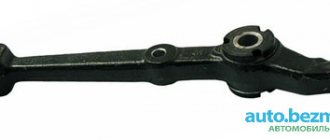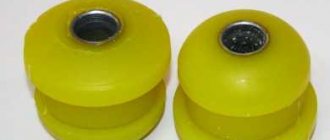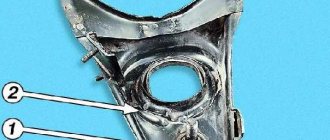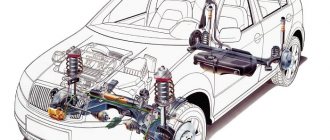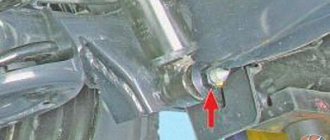What is a silent block?
The word “ silent block ” is of foreign origin; translated from English “silent” means silence and “block” means detail. A silent block or “silent” is a rubber-metal part; in other words, it is two bushings connected to each other by a thick layer of durable rubber. This invention, in addition to providing comfortable and silent movement in a car, has a number of advantages that I cannot list.
What are silent blocks needed for?
- Silent blocks prevent beatings and vibrations that occur during vehicle movement between various parts of the chassis and engine compartment.
- They protect parts from wear and tear by damping vibrations.
- They dampen vibrations coming from the wheels and chassis, thereby ensuring a soft and comfortable ride.
And these are just the main advantages of silent blocks; in fact, there are many more of them. However, today we will talk a little about something else, namely how to repair a car with your own hands, press out and press in silent blocks without damaging the part and your car.
When and why to change silent blocks?
Replacing silent blocks is most often done after the driver begins to notice a deterioration in the driving characteristics of his car or after the appearance of extraneous sounds (knocking, creaking, grinding), indicating the need to replace the silent blocks. Also, damaged silent blocks are often discovered during chassis diagnostics on a vibration stand.
If the silent blocks are not replaced on time, the owner risks even more breakdowns, which one way or another will arise due to faulty “silents”. For example, due to one damaged silent block, the load begins to be distributed unevenly, resulting in generation in other connections and nodes. As a result, instead of just one bushing, you will have to fork out money to replace all the silent blocks of the rear or front suspension.
Moreover, one should take into account the fact that a faulty suspension affects: a deterioration in the level of comfort, increased fuel consumption, increased tire wear, and also increases the braking distance, as a result of which the risk of an accident seriously increases.
How to press out a silent block at home?
Replacing silent blocks is not difficult; for example, I personally became convinced of this when I replaced the silent blocks and shock absorbers on the rear suspension with my own hands. It is for this reason that you can often meet those who decide to independently replace silent blocks at home.
Method 1
First, let's talk about how this should ideally happen. The lever in which it is necessary to replace the silent block is taken, installed under the press on a special stand into which the old silent will be squeezed out, after which a special spacer is installed on top, which will squeeze out the old bushing. This method is used by service stations that have the necessary set of spacers and a powerful press of 10-20 tons.
Method 2
Most motorists, of course, do not have a powerful press, but many have a good vice or jack in the garage. Using a powerful vice, you can successfully squeeze out old bushings using a similar principle - a spacer into which the bushing will go and a spacer that will press on the bushing.
Jack. It would seem, how can a silent block be squeezed out with a jack? Everything is very simple, you need to weld a rectangular frame from some channel or corner at a height slightly higher than your jack and lever. The principle is as follows: we install the jack in the frame, after which we install the lever eye and the two spacers mentioned above on top of the rod. We create the necessary pressure, and the bushing is squeezed out of the seat. It should be noted that in most cases, a 3-5 ton jack is simply not able to cope with such work, so it is better to use 10-15 ton jacks.
Method 3
If you don’t have a jack or a press, and you have an insatiable desire to replace the silent blocks yourself, you can use the third method - using a simple press puller (a pin or a bolt with a nut). The principle is to create pressure by gradually tightening the nut on the stud; this method can be considered analogous to a vice. A pin with a washer of the required diameter is inserted into the eye through the silent block, then a spacer with a washer is put on the other side and the nut is tightened. Rotating along the thread, the nut creates the necessary pressure and forces the silent block to be squeezed into the “receiving” spacer. This “method” requires a strong, hardened stud with the same nut. If the nut or stud is soft, you won't succeed. For example, my pin began to bend due to pressure, after which the thread on the nut was torn off. However, there are thousands of those who managed to replace silent blocks using this particular method. The advantage of this method is its cost-effectiveness and convenience from the point of view of “mobility”, that is, you do not need, for example, to completely remove the entire hub or lever, you just need to have such a primitive press puller.
How to press out/press in a silent block using a press puller video
Method 4
This method can be classified as drastic or extreme measures. It consists in using all known methods and devices to extract the silent block from the mounting socket. The principle is to knock out the old silent block using a powerful screwdriver or a thick wedge-shaped piece of reinforcement. The task is to drive a screwdriver or something similar between the bushing and the silent block, thereby deforming the wall of the bushing inward. After the sleeve is crushed and fed inward, knocking it out is not difficult. Before you start knocking out the silent block, you need to burn out or squeeze out the inner bushing of the silent block and, if possible, any remaining rubber.
How to knock out a silent block using a screwdriver and drill
Method 5
The next method of removing a silent block cannot be called pressing out, since it, like the previous one, does not require the presence of a press; all that is needed is a metal blade, a screwdriver and a hammer. The principle is simple, but not safe. We remove the inner sleeve, then take the blade and start cutting the outer sleeve. We are trying to cut through the old silent block as much as possible without damaging the lever itself or the eye. It is advisable to make two cuts, after which using a flat screwdriver, the silent block is easily deformed and knocked out.
How to press in silent blocks with your own hands?
We have already talked about how to remove the silent blocks, now another problem arises, how to press in the silent blocks? This procedure is complex in that it requires certain skills and abilities. A silent block installed incorrectly or “at awry” will either not work or fail ahead of time.
Method 1
As with pressing out, pressing should ideally be done using a vice. The principle is similar, but exactly the opposite. Before pressing in the silent block, you need to use sandpaper to clean the seat from rust and remnants of the previous silent block. Then the eye is generously lubricated with soap solution or Litol-type lubricant. A lever is installed, a silent block is placed on top, after which, through a special mandrel, press pressure is applied to the spacer, which will press the silent block into the seat.
Method 2
When there is no press, you can press in the silent blocks using the above-mentioned vice or jack. The principle is the same as that of the press. A lever, bushing, spacer are placed and, under the influence of a vice or jack, the silent is pressed into the seat.
How to press in a silent block using a vice - video
Method 3
Press puller. If the silent block is small, then you can “put it in place” using the same press puller that was used to press the silent block out of the socket. Again, the principle is the same, only a pin and a thick washer are used as a press.
Method 4
Sledgehammer and brute force. I strongly do not recommend this method for the reason that it is generally considered as purely theoretical, that is, it allows you to press in silent blocks, but it is quite difficult to say what the consequences and quality will be. The principle is quite simple, we take a lever, put a silent block on it, and then sharply and strongly hit the silent block, causing it to go into the ear of the lever. The disadvantage is that it is quite difficult to predict the correct movement of the silent block; it can go into the seat awry. It is also possible for the rubber parts to “bite” and damage the silent block or lever itself. In short, the blow is very difficult to control, and often after such “experiments” you have to go to specialists and redo everything. Therefore, think carefully before using this method.
Method 5
method I know of is to use the weight of the car. The principle is to use the weight of the car, so to speak, for personal gain. It all looks like this: a hydraulic or screw jack is installed under the car, the wheel is removed, although I think it is already removed if you are changing silent blocks, then a lever with a silent block is installed under the hub, which must be pressed in. Next, we align everything properly and begin to slowly lower the jack, it is better to have a friend or assistant help you. I think the weight of the car will be enough to press the silent block into the seat. The disadvantage of this method is that it is inconvenient and somewhat dangerous; in addition, it is quite difficult to control whether the silent block is correctly seated in the seat. However, if you have no other option, then the method is well worthy of your attention.
In principle, that’s it, I don’t know to press out or press in silent blocks If you know any other options worthy of attention, I will be happy to listen to them and publish them. Share your opinions from what you read and comment, I will be glad to see any constructive criticism. I also remind you that the best way to say thank you to the author of the article is to share this article with your friends on social networks using special social buttons. networks located just below. Peace and goodness to everyone, see you again at VAZ Repair.
Everyone who has a car is familiar with the problem when
there is a need to press out or press in silent blocks.
You don’t always want to turn to specialists, and doing it yourself is much more pleasant. Thanks to this article, you will learn what silent blocks are, why they are needed, and most importantly, how to press them in and press them out at home using different methods.
Let's sum it up
The front suspension in LADA Kalina is quite simple and reliable. Its design was “worked out” on the previous generation of the model. The manufacturer met the customers halfway in this matter and made the chassis of the Russian car suitable for repairs.
Also, as we have seen, the option of tuning the suspension is possible, the main thing is to know the design of the front suspension, this will also be useful if replacing the silent blocks is necessary. This solution is popular among owners, because it allows you to improve and balance the chassis characteristics, which in turn gives comfort while driving.
What is a silent block
This word is of foreign origin. Translated from English, silent means silence, and block means detail. A silent block, or simply “silent,” is a rubber-metal component; in ordinary words, these are two bushings that are connected to each other by a layer of durable rubber. This invention, in addition to guaranteeing comfortable and silent movement in a car, has a number of advantages that will be listed below.
Purpose and functions
Silent blocks perform the following functions:
- Protect components from wear and tear by damping vibrations .
- They dampen vibrations that come from the chassis of the wheels, thus providing a comfortable and soft ride.
- Prevent vibrations and beatings that appear during the movement of the car between different elements of the chassis and engine compartment.
And these are just the main advantages; in fact, there are many more.
Right choice
The choice is made after diagnosing the malfunction or during a planned replacement. It is necessary to understand what role the part plays in the suspension. Its task is to dampen vibrations that inevitably arise due to unevenness on the road.
Vibrations during movement are transmitted to the suspension springs, where they are partially damped by shock absorbers. The vibration then spreads to the frame through the connecting nodes. It is partially damped by silent blocks due to the presence of a soft base between the bushings. Therefore, the quality of the base must be of a high level. The factory version of the suspension is equipped with rubber-based silent blocks. This is a proven material, but there are better ones - for example, polyurethane.
- The service life is increased by 5 times. This allows replacements to be made after long mileage intervals and the suspension to be loaded more aggressively.
- Increased thermal stability. Polyurethane tolerates temperature changes well. The material works just as well in cold weather as at high temperatures.
- Thanks to the dense structure of the material, vehicle handling is improved.
Rubber and polyurethane are equally popular. Drivers themselves choose what to focus on. With rubber spacers you can get increased riding comfort, but improved handling can only be achieved with polyurethane. But in the latter case, comfort decreases, which is especially felt by passengers.
How to understand when it's time to replace
Before you set out to press in these parts, you should first of all inspect them thoroughly to make sure that they really require replacement.
Check for holes and any deformations, for swollen rubber on the hinges and for cracks. Manipulate the components, determining the presence of backlashes. If the permissible norm is exceeded, then replacement of parts is inevitable. It is not recommended to delay the pressing procedure. Over time, this problem will only get worse and can lead to suspension arm failure. The main indicators that indicate the failure of one part or several:
- Driving the car has become much more difficult.
- When overcoming bumps, the suspension begins to knock loudly. Tires wear unevenly, which has not been observed before.
- It has become much more difficult to adjust wheel alignment.
Front suspension device
The front suspension of the Lada Kalina is independent on MacPherson struts. This suspension is the most common in the automotive world for its price and acceptable characteristics for this price. Previously, Lada used this suspension, for example, in Lada Samara, but it was much poorer in equipment than MacPherson, although it was 90% similar to it.
So, the Lada Kalina suspension consists of the following components:
- Stabilization bar;
- Brackets for securing the stabilization rod;
- Cross arm mountings;
- Front suspension arm;
- SPU (anti-roll bar) bases;
- Telescopic front suspension strut;
- Ball-shaped supports;
- Kulaga;
- Longitudinal stretch;
- Stretch mounts.
Necessary materials
To press this part into place at home, you will need the following tools:
- Mount;
- Jack;
- Set of wrenches;
- New hinges.
It is recommended to use machine oil or other types of lubricant as a lubricant.
Among other things, you will need special mandrels designed for pressing silent blocks; as an alternative, you can use a piece of pipe with the required diameter. You also need to get a press to press in a new rubber-metal hinge . When it comes to home use, an ordinary vice can serve as a press. In addition, you can stock up on a set of sledgehammers, but with this approach it is necessary to maintain high precision in the work.
Pressing out at home
Replacing these parts is not as difficult as it might seem at first glance. For example, many car owners made sure of this when they replaced parts, using special equipment for self-replacement. It is for this reason that there are many people who have decided to replace silent blocks with their own hands and at home.
First method
First of all, let's learn about how it should be ideally.
The lever in which the rubber-metal hinge needs to be replaced is installed on a special spacer for the press. The old silent will be squeezed onto this spacer. Then another spacer is installed on top - it squeezes out the old bushing. This method is used by service station workers, since they have the necessary set of spacers and a powerful press of 10-20 tons.
Second method
Almost all car owners, naturally, do not have a powerful press, but many have a jack or a good vice in their garage. If you use a powerful vice, you can successfully squeeze out the old bushings according to the principle that is already familiar to us: a spacer for the original bushing and a spacer for pressing on the bushing.
At first glance, it becomes unclear how you can squeeze out the silent tape with a jack? Everything is very simple: you need to weld a frame in the shape of a rectangle from a channel or corner so that its height is slightly higher than the lever and the jack. The operating principle is as follows: place the jack in the frame, then install the lever eye on top of the rod, as well as the two spacers mentioned above. We create the required pressure, after which the bushing is squeezed out of its seat. It must be emphasized that most often a jack with a capacity of 3-5 tons is not able to cope with such work, therefore it is recommended to use 10-ton jacks.
Third method
If you have neither a press nor a jack, but still have a strong desire to replace the silent blocks on your own, you can use the third method - using a simple press puller (bolt with nut or stud).
The principle of operation is to create pressure by gradually tightening the nut on the stud; this method can be called an analogue of a vice. This pin with a washer of suitable diameter is inserted into the eye through the silent block, then on the other side you should put on a spacer with a washer and tighten the nut. Rotating along the thread, the nut creates the necessary pressure and forces the silent to be squeezed into a special spacer.
This “method” requires the use of a strong, hardened stud and an equally strong nut. If you take a soft pin or nut, you will most likely fail. For example, there are cases when, due to strong pressure, the stud becomes bent, as a result of which the thread on the nut breaks. However, there are thousands of those who managed to change silent blocks using this particular method. After all, everything depends on the quality and strength of the material used.
The advantage of this method is its low cost, as well as its convenience, if you look at it from the “mobility” point of view. In other words, you don’t need, for example, to completely remove the lever or the entire hub; it will be enough to just have a simple press puller like this.
Fourth method
This method can be classified as drastic decisions or extreme measures. Its principle is to use all popular methods and devices to extract silent from the seat. To do this, you need to knock out the old part using a powerful screwdriver or a thick wedge-shaped piece of reinforcement. You need to try to hammer a screwdriver or something between the silent block and the bushing, thus deforming the wall of the bushing inside. Now that the bushing is crushed and pushed inward, it is not at all difficult to knock it out. Before you start knocking out the silent block, you need to squeeze out or burn out the inner sleeve of the part and, if possible, all remaining rubber.
Fifth method
The next method of removing a silent block cannot be called pressing out, since it, like the previous one, does not require the presence of a press: all you need is a metal blade, a hammer and a screwdriver.
The principle is simple, but unsafe. We remove the inner sleeve, then take the blade and start cutting the outer sleeve. Try to cut through the old silent as much as possible without damaging the lever itself or the eye. It is best to make two cuts, and then using a flat screwdriver, the silent block will be easily deformed and knocked out. If none of the methods listed above helped, and you still need to do it, there is only one option left - to entrust this work to specialists. To achieve the desired result, take the part and go to the service station, where specialists, using a silent block extractor and other special tools, will qualitatively do all the necessary work “in the blink of an eye.”
Adjusting the rear wheel bearings of Daewoo Nexia (8/16 valves sedan and hatchback, n150)
Proper adjustment is an important criterion for wheel bearing life. The only correct method of adjustment from a mechanical point of view and according to official operating instructions is to tighten the nut to the specified torque using a torque wrench.
Step-by-step adjustment instructions
- After screwing on the locknut, tighten it by hand until it stops.
- Without putting on the cotter pin, roll the drum in both directions to distribute the lubricant.
- Using a torque wrench, tighten the locknut to 2.5 Nm.
- Roll the drum in both directions
- Unscrew the locknut 180 degrees.
- Retighten the locknut to 2.5 NM.
- The bearing assembly is now adjusted correctly. Be sure to install the cotter pin. The whole process is also shown in the video.
Pressing in silent blocks
We have already talked in detail about how to get the “silents”, now another problem arises - how to press this part? This procedure is difficult because it requires certain skills and abilities. An incorrectly or crookedly installed silent will either not work or break prematurely.
First method
As with pressing, pressing should ideally be done using a vice. The principle is somewhat similar, but just the opposite. Before pressing the part, you need to thoroughly clean the seat from any residues and rust from the previous silent using sandpaper. Then the eye is generously lubricated with a lubricant like “Litol” or with a soap solution. A lever is installed, the part is placed on top, after which press pressure is applied to the spacer through a special mandrel. It will press the part into the seat.
Second method
When you do not have a press, you can press the part using the above-mentioned jack or a vice. The principle of operation is no different from a press. The lever, bushing, and spacer are installed. Then, under the force of a vice or jack, the part is pressed into the seat.
Third method
Press puller. If the silent block is small, you can “put it in its place” using the same press puller that was used to press the part out of the socket. Again, the principle is the same, only a thick washer and a pin are used as a press.
Fourth method
Using a sledgehammer and brute force. This method is not the best of all existing ones, since it is considered more from a purely theoretical point of view. In other words, it really allows you to press a part, but it’s very difficult to say what the results and quality of work will be. The principle is quite simple: we take a lever, put a silent on it, and then hit it quickly and hard.
Necessary tool
To press in silent blocks at home, you will need the following tools: a set of wrenches, a jack, new hinges, a pry bar. For lubrication you will need to use machine oil or other types of lubricant.
You will also need special mandrels for pressing in silent blocks, as an alternative - pieces of pipe with the required diameter, as well as a press for pressing in a new rubber-metal hinge. At home, this press can serve as a regular vice. You can also prepare a set of sledgehammers, but you must maintain high precision in the work.
Replacing the silent block of the rear suspension beam lever Lada Kalina 1117 2004 - 2013
Tools:
- Jack
- Support posts
- Open-end wrench 10 mm
- Straight box spanner 19 mm (2 pcs.)
- Wheel key
- Torque wrench
- Cup puller for wheel bearings
Parts and consumables:
- Wood block
- Cylinder head screw
- Soap
- Water
- Rags
- Screw d=12 mm
- Pipe sections to fit the silent block
- Silent block
Note:
We carry out the work on an overpass or inspection ditch.
1. We hang out the back of the car. To make the job easier, remove the wheel.
2. Using a 10mm wrench, unscrew the nut and disconnect the parking brake cable from the rear suspension beam.
3. We remove the cable sheath from the holder on the rear suspension beam mounting bracket.
4. Use a 19mm spanner to unscrew the nut, hold the bolt securing the lever to the bracket with another wrench of the same size and remove the bolt.
5. We insert a wooden block between the body and the beam. At the same time, make sure that the brake hose of the rear wheel is not stretched.
6. Using a cup puller for wheel hub bearings or suitable pipe sections, press the silent block towards the threshold of the car. The wheel bearing puller bolt does not fit into the hole in the silent block, so we replace it with a bolt or screw d 12 mm (the cylinder head mounting screw is suitable).
7. Squeeze the silent block into the puller cup.
8. We clean the hole for the silent block in the lever from dirt. We wet the new silent block and the hole in the beam with soapy water.
9. We insert the silent block into the hole in the lever and press it in with the same puller.
10. Having lowered the car onto the wheels, tighten the nut of the bolt securing the lever to the bracket with a torque of 67-82 Nm.
The article is missing:
- High-quality photos of repairs
How to check silent blocks
To press in the hinges, you need to inspect them thoroughly, making sure that their replacement is definitely necessary. To do this, you need to visually inspect the silent block and check its integrity. You need to make sure that the rubber on the hinge does not swell or crack. Check the play in the parts; if they exceed the size, then replacement is necessary. There is no need to delay this work; if it is not done in a timely manner, problems may arise that will lead to a complete replacement of the suspension arm.
Standard reasons that indicate their malfunction:
- poor handling;
- when driving over uneven surfaces, knocking sounds appear in the suspension;
- tire wear occurs unevenly;
- problems with wheel alignment adjustment.
Front suspension Lada Kalina
Lada Kalina first appeared on the Russian market on November 18, 2004. It was with this car that a new era in the development of the Volga auto giant began.
This machine was produced until 2013, and its total circulation reaches 600,000 pieces. The car has become new in everything, from the platform to the ergonomics of the interior. The front suspension of this car is independent, MacPherson type, which is a significant advance for the Lada company.
Press-fitting instructions
At the initial stage, it is necessary to visually assess whether the new silent block is suitable for a particular case. This condition must not be neglected, so that later it will not be too late. There are often cases when the outer part fits perfectly, but the inner part does not, and vice versa. Once you determine that the parts will fit exactly, you can proceed to the next step. To do this, you should use a vice to help press it correctly. This method is safer and more accurate.
You can also use hammers and sledgehammers, but you need to be more careful and carefully monitor the accuracy of the process.
Thus, you will need to land several hits. If after this the broken silent block is firmly held in the hole, you need to knock it out. For this work, special mandrels are used for pressing silent blocks or two pieces of pipe. The diameter of one of these parts must correspond to the parameters of the outer joint bushing. When knocking out a part, you do not need to worry about damaging it, since it is faulty. This process is carried out with a regular hammer.
You can make it easier and faster to knock out the old hinge by heating it with a special burner. It is worth remembering that as a result of this procedure, the part breaks completely.
After knocking out is completed, the eyelet in which the hinge was located must be cleaned of dust, dirt, and so on. The seat for the new part must be perfectly smooth and even. There should be no mechanical damage or various scratches on it. In addition, there should also be no sharp edges.
After cleaning the seat, its surface must be treated with lubricant. If this is not available, you can use a regular soap solution. A device such as a metal polyurethane bushing must also be lubricated. Having completed the lubrication of the seat, you can begin to clamp the lever in a vice. In this case, it will be necessary to install a silent block perpendicular to it. This work is done as smoothly as possible. The further normal functioning of your machine depends on this.
Next, you will need to choose how to press in the silent block - press it in or drive it in with a sledgehammer. To reproduce this process, you will need metal tubes or mandrels for pressing silent blocks, one of which will need to hold the lever. And the other tube must be leaned against the side to avoid damage to the hinge when working with a vice or hammer.
The main difficulty with this work may be the difficulty of pressing the hinges into their original place. To perform this procedure, I recommend using a special press to press them in and out with the levers, as well as a mandrel for pressing in the silent blocks. You can also use improvised means, such as pieces of pipe and a sledgehammer, but you should be very vigilant and attentive, since this process requires high precision and dexterity so that the result is a whole polyurethane insert.
You can press in silent blocks with your own hands only on the front and rear parts of the suspension. If you need to replace rubber-metal joints in engine or gearbox components, you should contact a specialist. This is necessary precisely because replacing parts in such units is a labor-intensive process. To implement it correctly, you must have repair experience and a good knowledge of the main components of the car's structure. If you lack experience and knowledge, it is better not to test your luck and entrust your car to specialists. Because, in addition to the time spent, you will spend a lot on replacing silent blocks.
Disassembling the steering mechanism
Remove the steering rod support. We insert the bit into the groove of the crankcase pipe mounting nut.
We unscrew the nut, striking the beard (right-hand thread).
. and remove the crankcase pipe.
Use a screwdriver to press out the two clamps of the bushing located inside the pipe.
. and remove the bushing.
Remove the two rubber O-rings from the bushing.
Steering rack bushing (arrows indicate bushing clamps)
.
If it is necessary to replace the nut, use pliers to remove the locking rings. . and remove the retaining ring.. Remove the pipe securing nut.
Remove the rubber plug from the rack stop adjusting nut. Using a scraper, remove the jammed metal in the locking areas of the stop adjusting nut.
